
Hypena rostralis, the buttoned snout, is a moth of the family Erebidae. It is found in Europe far into Scandinavia.Then through the Palearctic into Asia Minor, the Caucasus and east to Siberia. It is widespread at forest edges, forest clearings, shore areas, in gardens, park landscapes and cultivated land and rises in the mountains up to 1600 m.

Hoplodrina blanda is a moth of the family Noctuidae. It is found in the Palearctic realm.
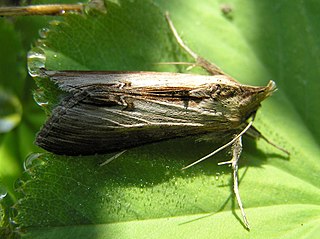
Cucullia asteris, or star-wort, is a moth of the family Noctuidae. The species was first described by Michael Denis and Ignaz Schiffermüller in 1775. It is found through the Palearctic including Japan.

Dysgonia algira, the passenger, is a moth of the family Noctuidae. The species was first described by Carl Linnaeus in 1767 and is found in the Palearctic - from the southern half of Europe and parts of North Africa through West, Central and South Asia.

Euxoa obelisca, the square-spot dart, is a moth of the family Noctuidae. It is found in the Palearctic realm.

Mesapamea secalis, the common rustic, is a moth of the family Noctuidae. The species was first described by Carl Linnaeus in his 1758 10th edition of Systema Naturae. It is found in Europe, north-west Africa, Turkey and northern Iran.

Dichagyris musiva is a moth of the family Noctuidae. It is found in some mountainous areas of Europe, Turkey, Armenia, the Caucasus, Anatolia, southern Siberia, Mongolia, Tibet and western China.
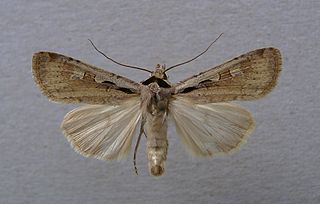
Dichagyris flammatra, the black collar, is a moth of the family Noctuidae. The species was first described by Michael Denis and Ignaz Schiffermüller in 1775. It is found in central and southern Europe, Morocco, Algeria, Egypt, western Siberia, Armenia, the Caucasus, Turkey, Lebanon, Syria, Iraq, Iran, Tibet, Afghanistan and northern India.

Lygephila craccae, the scarce blackneck, is a moth of the family Erebidae. It is found in temperate Europe and across the Palearctic to the Altai Mountains, Korea, Japan and China.
Hadena clara is a species of moth of the family Noctuidae. It is found in Morocco, southern Europe, Turkey, Armenia, Azerbaijan, the Caucasus region, Israel, Lebanon, Syria and Iran.
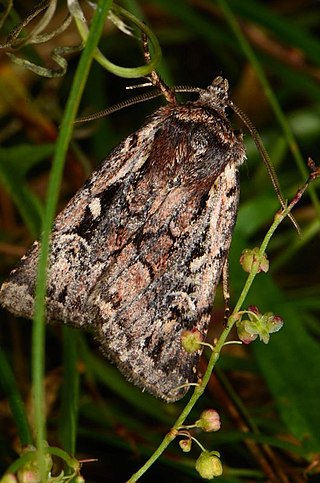
Xestia agathina, the heath rustic, is a moth of the family Noctuidae. It is found in western and central Europe and Morocco.
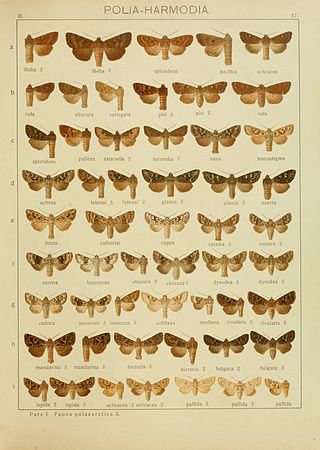
Lasionycta calberlai is a moth of the family Noctuidae. It is found in France, Switzerland, Italy and Slovenia.

Dichagyris celsicola is a moth of the family Noctuidae. It is found in Greece, France, Italy and Turkey. It might also be present in Iran and Iraq.

Dichagyris forcipula is a moth of the family Noctuidae. It is found from central and southern Europe and Algeria, east to the Caucasus, Turkey, Syria, Lebanon, Iraq and Iran.
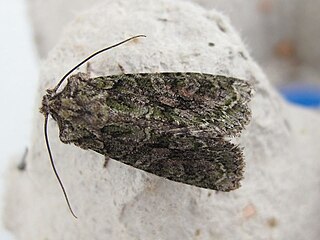
Dryobotodes eremita, the brindled green, is a moth of the family Noctuidae. The species was first described by Johan Christian Fabricius in 1775. It is found in most of Europe, east to Turkey.
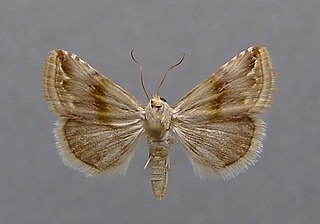
Eublemma ostrina, the purple marbled, is a moth of the family Erebidae. The species was first described by Jacob Hübner in 1808. It is mainly found in central and southern Europe, and further east, but is also a scarce migrant in the United Kingdom, where it is mainly found along the south coast.

Chloantha hyperici, the pale-shouldered cloud, is a moth of the family Noctuidae. It is found in southern Central Europe and from southern Europe to the Near East and Anatolia, Israel, Iraq, the Persian Gulf and the Caucasus, as well as northern Denmark, southern Sweden, southern Norway and south-western Finland.

Mniotype adusta, the dark brocade, is a moth of the family Noctuidae. It was described by Eugenius Johann Christoph Esper in 1790. It is found throughout much of the Palearctic from Europe to Japan, China and Mongolia. It is also found in North America. The habitat consists of heathland, chalky downland, fenland, moorland and upland areas.

Dichagyris renigera is a moth of the family Noctuidae. It is found in South- and Southeast-Europe, Armenia, Caucasus and Turkey.

Haemerosia renalis is a moth of the family Noctuidae. It was described by Jacob Hübner in 1813. It is found in Spain, France, Italy, Sicily, Bosnia and Herzegovina, Serbia, Croatia, Slovenia, Bulgaria, North Macedonia and Greece. It has also been recorded from the Near East.



















